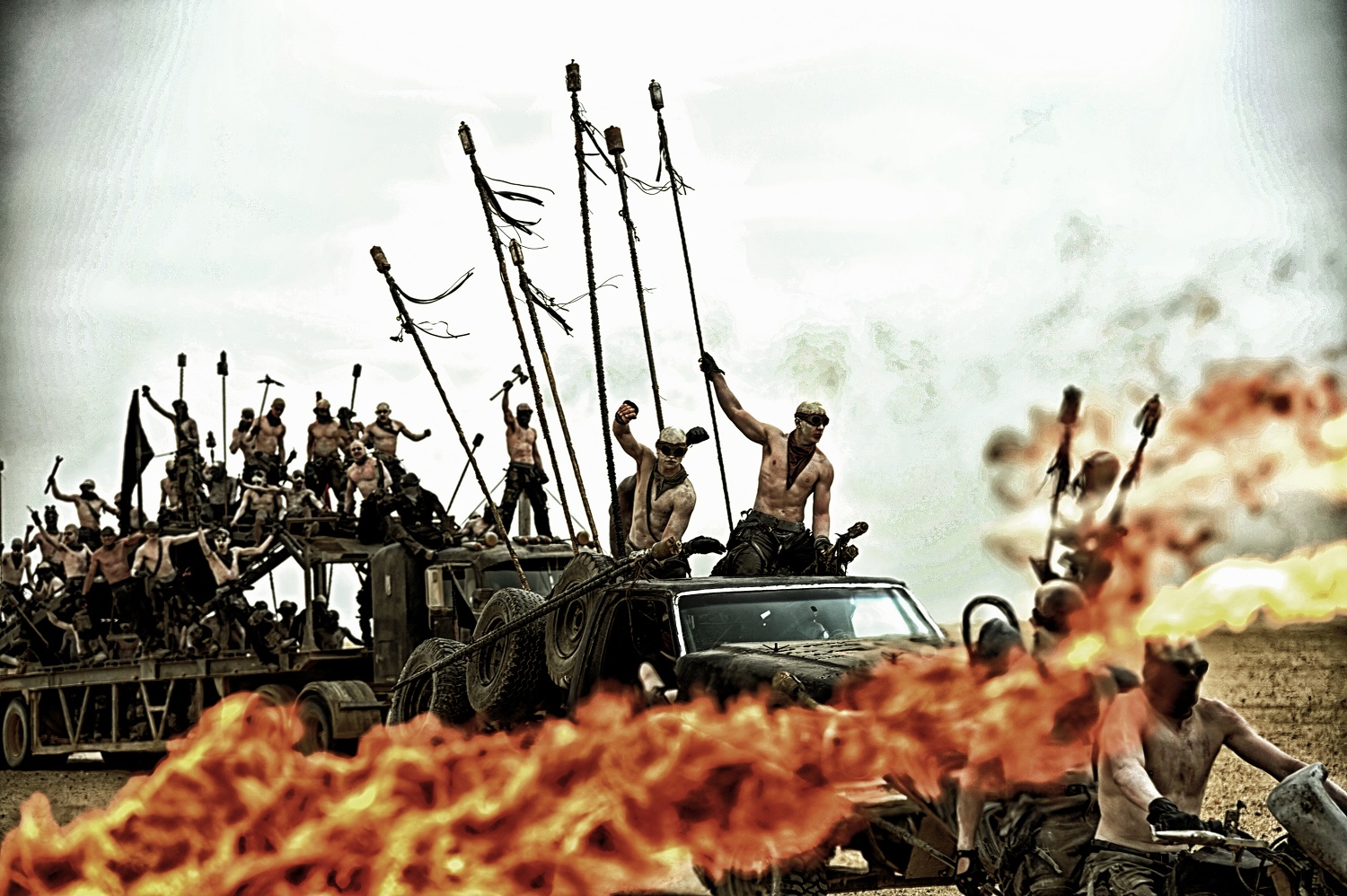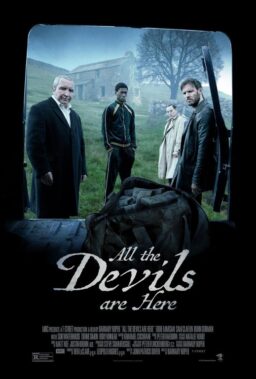“Mad Max: Fury Road” exploded across screens this weekend in
plumes of cherry red and saffron yellow smoke, with swarms of chalk-dusted
bodies coiling across monstrous vehicles the color of dried blood. It’s a
thrilling, excessive spectacle, from the mind of 70-year-old Australian
director George Miller. To understand where exactly “Fury Road” is coming from,
it helps to know a man named Enzo G. Castellari, director of films with such
amazing titles as “Any Gun Can Play” and “Kill Them All and Come Back Alone.” Few
genres better encapsulated the excesses and anxieties of the ‘70s and ‘80s than
post-apocalyptic movies. And few genres were an utter free-for-all of madness
and color like the Italian post-apocalyptic movies that filled shelves of video
stores from Montana to Missouri. Their American cousins tended to be serious or
at least take for granted that all was about to be made glass and ash by the
Big One, and set about to discover what humanity would make of itself in the
ruins. Italian post-apocalypse was gaudy, cared not a whit for internal story
logic, and if it could also cash in on several other current hits so much the
better.
There had been “life after the mushroom cloud” stories before,
but it was “Mad Max” (1979) that pointed the way for what was to come. A modest
hit in the States, it was mishandled by its overseas distributor AIP. Deciding
to dub the cast with flat American accents and understandably troubled by how
to sell such a genuinely strange film, they settled for a generic cop on the
edge angle; “Dirty Harry” in muscle cars. 1981’s “Mad Max 2: The Road Warrior”
was a different story. It made a bundle across the globe, striking a particular
nerve in Italy. An odd reaction until you consider that the film is at heart a
Spaghetti Western. The lone gunslinger comes to a frontier town under siege. He
saves the day, shoots enough people, and wanders off alone into the sunset, for
his heart is heavy and peace can never be his. Also, and perhaps even more key
to “Road Warrior” cash-ins becoming a cottage industry, they were cheap. If you
could attach spikes to a dune buggy and spray paint a mohawk pink, you had a
post apocalyptic movie half in the can.

Of the first wave of imitators, Castellari’s “1990: The Bronx
Warriors” (1982) is one of the best. Mixing “The Road Warrior” with the next
two biggest influences on Italian post-apocalyptic movies, Walter Hill’s “The
Warriors” (1979) and John Carpenter’s “Escape from New York” (1981), the
director steers a mad concoction of Old Dirty NYC second unit footage, Fred
Williamson in red satin pirate blouses, motorbikes with plastic skulls stuck to
them, and very, very dangerous street mimes. It was followed by a loose series
of sorts, “Escape from the Bronx aka Escape 2000” (1983) which got its lumps on
“MST3K” (“Toblerone!”), and “2019: After the Fall of New York” (1983) which
beat “Children of the Men” (2006) to the punch by 23 years in dealing with the
hero trying to smuggle the last fertile woman on Earth to safety.
Meanwhile, other countries were getting into the act. As
expected, the aftermath in Australia’s neighbor New Zealand tended to be quieter
and involve more sweaters. “Battletruck” aka “Warlords of the 21st Century”
(1982) was the most obvious “Road Warrior” clone but made good use of
contrasting the violence with the country’s pastoral landscapes. “The Quiet
Earth” (1985) on the other hand, took its cues from “The World, The Flesh, and
The Devil” (1959) with the attendant trouble of when “The Last Man on Earth”
finds out that ain’t necessarily so. Canada had astronauts watching helplessly
as the clock struck midnight in “Defcon-4” (1985). And Great Britain gave new
depths to “bleak” in “Threads” (1984).

But it was Italy that kept the fly by night video labels
working overtime, mixing and matching from whatever was a hit at the time and
putting in it the desert. If you wondered what “Blade Runner”’s cityscapes
would look like constructed out of cardboard tubes and Christmas lights, “2020
Texas Gladiators” (1982) has your answer. If you were curious if a producer
ever just handed a director the poster in lieu of a script and said “match
this,” David Worth, director of “Warrior of the Lost World” (1983) confirms so
in an interview. It was a wild, crazed gold rush, supported by hungry
distributors and independent production houses like the gloriously infamous
Cannon Films. There was no gang theme too outre, no future slang too forced to
not be given a try. The output was such a ridiculous torrent it was only
expected that genre exhaustion would come sooner than usual, and one of the
first signs was the franchise that had started it all.
“Mad Max: Beyond Thunderdome” (1985) is an interesting film
that can’t quite escape its Frankenstein-ish origins. Director George Miller
took a script about a group of feral children he’d been unable to get into
production and awkwardly worked it into the second “Mad Max” sequel. But just
as much as its seams showed it had some of the most exhilarating action
sequences of the decade and a great Maurice Jarre score. The same could not be
said of the increasingly threadbare Italian fare. For those committed to
seeking out the residue that sticks on the other side of the bottom of the
barrel, 1987’s “Interzone” is a dismaying example on multiple levels, exhibiting
that last gasp of any trend: “Uh oh, it’s almost over so let’s make a spoof of
it!” It might not have been such a bad idea if the script, or the acting, or
the directing could agree on what was actually supposed to be funny. Everyone
looks embarrassed, confused or some combination of the two with only female
bodybuilder Teagan Clive deciding to have a ball and play her villain as though
Roseanne Barr had been cast as Thulsa Doom.
The end of the Cold War provided a natural death for the genre,
but, curiously, as it becomes apparent we’re capable of destroying our
civilization without any outside existential threat, post-apocalyptic movies seem
to be seeing a revival (mainly through the dystopic lens of properties like “The
Hunger Games”) It seems right that when the world won’t stop burning, Miller
returns with the original. But a funny thing has happened in the 30 years since
“Thunderdome.” As much as Italy took from him, he seems to have paid equal
attention to what they were turning out. “Fury Road” is full of arresting,
bizarre images. In a ruined swamp, costumed figures on stilts poke through the
gloom, suggesting that a Cirque du Soleil troupe survived the apocalypse. In a
ghoulishly brilliant touch, the “war boys” of the villainous Immortan
Joe spray paint their mouths in chrome before suicide attacks so their teeth
resemble the grills of their sacred cars in death. About all “Fury Road” is
missing is Fred Williamson as an untrustworthy town boss. And if that’s not
enough, there is a perverse strain of decency running through the carnage, because all this is ultimately about respecting the rights of women to their
own bodily autonomy….no, really.
And here is the great secret of my love of post-apocalyptic movies.
It’s an oddly hopeful genre. Yes, there are entries where we all fall down, but,
more often, it’s about reaching safety, finding water, the lost city, getting
the gasoline out, etc. There is terrific comfort in being reminded that,
despite our best efforts, despite all the intentions of our best and brightest,
we manage to outwit ourselves and continue on another day. There is always a
reason to build a fire, to tell the story, to look out for one another. And if
we can be reminded of that via car chases and a flame belching guitar, well, what’s
the harm in that?













